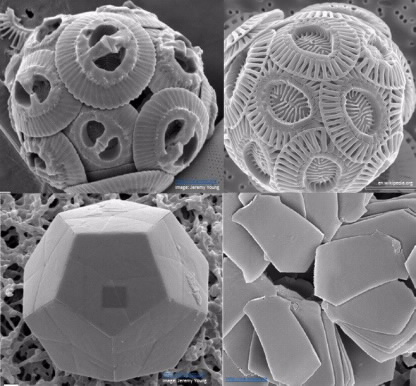
Coccolithophores: Earth’s tiny workers (a poem)
(photos from http://ina.tmsoc.org<)
Coccolithophores are single-celled, marine algae With shells made up of CaCO3 Most of them live in the ocean’s upper photic zone They are the base of the food chain, eaten by zooplankton.
Sunlight and nutrients they do share at the surface When all of them are there, nutrients become scarce Though in the lower photic layer, some prefer to live there Where nutrients are abundant and light is rare.
These are coccolithophores, the organism is inside
Surrounded by calcite scales that are preserved when they die
They are called coccospheres, when preserved as a whole
Or termed as coccoliths in their disaggregated form.
They have organic base plate scales with complex ornamentations
That collect CaCO3, the process is calcification
And then they form all these intricate structures
Remarkable pieces of Earth’s architecture.
They are minute, approximately 2 to 30 microns in size
You cannot see them with your two naked eyes
Light or scanning electron microscopes is what we use
We identify and count them to find some clues.
So you can just imagine how much they can cover
Oceans with areas of thousands of kilometers
If they gather altogether, they can form a bloom
There can be thousands of them or even millions.
In the global carbon cycle they play a significant part
They have combined effects on biological and carbonate pumps
Huge amount of CO2 is sequestered via photosynthesis
And by calcification, back to the atmosphere, the CO2 is released.
Together with other guys like foraminifera and pteropods
For the ocean’s vertical gradient alkalinity, they are responsible
Coccolithophores also form organic compounds called alkenones
Depending on the sea surface temperature, they vary in configuration.
And when these organisms die, their remains fall
Drift down by the currents to the bottom, down the floor
One of their enemies though is the calcite compensation depth
Where they will most likely get dissolved and experience double death.
But for those that have managed to reach the seafloor
They build up in the sediments, stay for years and more
Over the geologic time, as seas advance and retreat
Tectonic plates moving around can expose those beneath.
Though not all have to wait that long thru the geologic time
To be exposed to the surface and see the day light
Yes, there are those like the famous white cliffs of Dover
But there are also those sediment cores collected with a corer.
Some theories about them may still be debatable
But we cannot negate the fact that they have important role
If we hope to understand our current and future climate
It is imperative that we understand the Earth’s past state.
Our oceans, they present a unique opportunity
For scientists like us to discover and study
For thousands of years, marine sediments can remain untouched
They provide excellent records for reconstruction of the past.
Now I have this chance to sail with the Joides Resolution
Find some of them in the cores that we will get in this expedition
Under the microscope, I will always gaze at them in awe
For I can never fathom, the depths of what I am to know.